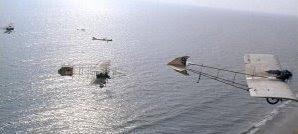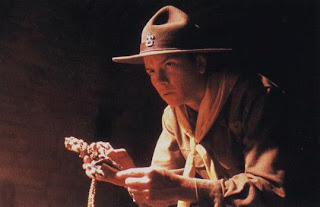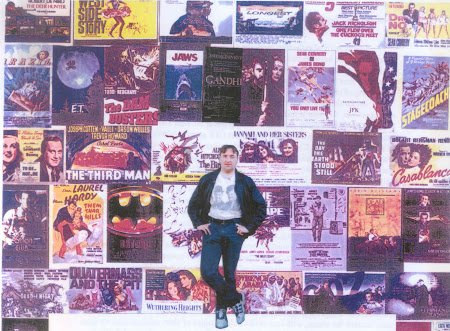Or: How I Flew from London to Paris in 25 Hours 11 Minutes, to give its full title - part of the 60s vogue in British cinema for eccentric, long-winded film titles that emphasised the playfulness of the whole enterprise. Those Magnificent Men... (which I will abbreviate thus for simplicity's sake) is a comedy first and foremost, but it's also a good adventure yarn with a romantic triangle sub-plot, and some breathtaking scenery when the vintage planes are in the air. It's also for me, one of those fun family films that I used to enjoy watching on television when I was younger, with a host of familiar faces, and a great, jolly score by Ron Goodwin.
It captures the excitement of air travel (the Space Age of its time) combined with the humour of those daring would-be aviators all over the world who tried and usually failed to reach the skies.
The film opens in this vogue, with the Twentieth Century Fox fanfare played as if by a small tinny band in an old Edwardian theatre, and the first face we see is that of "Neanderthal Man" Red Skelton, looking up at a seagull flying in the sky, and thinking of emulating the feat. But flying, as narrator James Robertson Justice points out, "was strictly for the birds." Falling flat on his face, this does not prevent the amusing Mr Skelton from trying the feat many other times in the generations to come, leading up to 1910, the period setting of the story. Playing around with history, several actual attempts at flying machines are topped by one such creation of Emilio Ponticelli (Alberto Sordi), who makes "what many people claim was the first long distance flight" - of about 100 yards, before coming down to land with a bump - as he will a few more times in this movie.
Mr Justice declares that "Man had conquered the air, and people everywhere were all agog about, those magnificent men in their flying machines", which segues in Ronald Searle's amusing title sequence (animated by Ralph Ayres). The film gets underway at last when Lt. Richard Mays (James Fox) of the Coldstream Guards - a future Biggles in the making - touches his plane down. His fiancee, the rebellious but delectable Patricia Rawnsley (Sarah Miles), is desperate for Richard to take her up into the skies. If their on-screen chemistry seems rather good, that could be due to the fact that off-screen James Fox and Sarah Miles were lovers at the time, and here co-starring together in a much more light-hearted film that their previous teaming, The Servant with Dirk Bogarde.
rebellious but delectable Patricia Rawnsley (Sarah Miles), is desperate for Richard to take her up into the skies. If their on-screen chemistry seems rather good, that could be due to the fact that off-screen James Fox and Sarah Miles were lovers at the time, and here co-starring together in a much more light-hearted film that their previous teaming, The Servant with Dirk Bogarde.Patricia's stuffy father however, Lord Rawnsley (Robert Morley), forbids such ideas of his daughter flying, but is much more enthusiastic to Richard's idea of organising an air race between London and Paris, intending to show "that Britain not only rules the waves, but intends in future, to rule the skies!"
His bewildered liaison officer Gascoyne (Willie Rushton) is given the task of informing the rest of the world's aviators about the race, and the glittering £10,000 prize (in various other currencies), and a pretty rogue bunch they are too: the womanising Pierre Dubois (Jean-Pierre Cassel) who can't take his eyes off Irina Demich - as "Brigitte", "Ingrid", "Marlene", "Francois", "Yvette" and "Betty"(!) If the French seem eccentric, this is nothing compared to the batty, buffoonish Germans, led by Gert Frobe, who believe everything is possible with a book of instructions to slavishly follow.
Late into the international affair, as ever, come the Americans, as represented by Stuart Whitman as Orvil Newton, and his associate George (Sam Wanamaker), who just doesn't share Orvil's passion for flying: it isn't the going up that discourages him, but the different ways Orvil keeps finding of coming down!
The aforementioned Emilio Ponticelli is having similar problems landing, and vows to his children and long-suffering wife Sophia (Zena Marshall - a stunning take-off of Sophia Loren), that he will retire from flying - until he sees the irresistible offer of the big prize air race, and "like-a Caesar, we go to England!"Lastly, we have the Japanese pilot Yamamoto (Yujiro Ishihara), who responds to the task given him by his lord and master, with the astonished statement, in a beautifully polished English accent (dubbed by James Villiers): "ten thousand pounds!"
However, last and by no means intending to be least, comes the rascally Sir Percy Ware-Armitage(!), played gloriously by Terry-Thomas, and the undoubted inspiration of the cartoon character Dick Dastardly.
 "That bounder" Sir Percy is not only going to join the race but is going to win it, by whatever underhand means he can, with the unwilling help of his seedy, henpecked valet Courtney (Eric Sykes). Their scenes together are the best of the film - the ground-based ones - but there are many other amusing set pieces too, not least the Keystone Cops-style firemen, led by Benny Hill - one of a number of famous 60's TV stars who pop up in cameo roles. Others include Millicent Martin, John Le Mesurier, the aforementioned Willie Rushton, and the king of all the sitcoms at the time, Tony Hancock.
"That bounder" Sir Percy is not only going to join the race but is going to win it, by whatever underhand means he can, with the unwilling help of his seedy, henpecked valet Courtney (Eric Sykes). Their scenes together are the best of the film - the ground-based ones - but there are many other amusing set pieces too, not least the Keystone Cops-style firemen, led by Benny Hill - one of a number of famous 60's TV stars who pop up in cameo roles. Others include Millicent Martin, John Le Mesurier, the aforementioned Willie Rushton, and the king of all the sitcoms at the time, Tony Hancock.The scene where the firemen are being chased all round the airfield by the poor German pilot (Karl Michael Vogler) who can't get his plane to stop, always had me in stitches, especially when his own German troopers have to scurry away when the plane comes towards them. In to save the day however, comes the buccaneering Orvil Newton, who has quickly won over the lovely Patricia - who sees a chance in being taken up into the skies that her fiancee denied her. The love triangle that develops therefore, between Orvil, Patricia and Richard, reminded me in some ways of the similar Han Solo/Princess Leia/Luke Skywalker love triangle in Star Wars.
Orvil gets into hot water as a result, after a narrow escape when he succumbs to Patricia's pleadings and takes her up for a joyride. The stuffy Lord Rawnsley is enraged at first, but Patricia persuades him otherwise, and off Orvil goes with all the others, on the perilous quest to fly from London across the Channel to Paris.
Before that however, those two old rivals France and Germany want to settle a few scores. The Germans demand satisfaction for being made to look like fools (as if they weren't already!), but the impish French suggest "balloons and blunderbusses" as the choice of weapons! The resulting airborne duel ends with both of them landing in the sewage, as well as poor old Emilio again. The treatment of the various nationalities in the film is of course, amusingly stereotypical - particularly of the Germans - in an old-fashioned, It's a Knockout kind of way, but it has to be taken within the context of the film as a bit of fun, for all its xenophobia.
The race begins at last, with the shock early exit of the Japanese - thanks to the handiwork of that naughty butler Courtney, and the rascally Sir Percy, who also removes one of Orvil's wheels, but the "Yankee chap" still manages to land at Dover (the first set-off point) OK, and patches the damage up overnight in time for the next stage of the race, across the Channel.
The fiendish Sir Percy however, is at it again, ahead of everyone else by crossing the Channel at night - not by plane, but [boo, hiss!] by boat, smuggling his flying machine across the seas. His inevitable comeuppance however, comes along courtesy of the good old steam train - which looks peculiarly English for a French railway line, and there's also a beautiful continuity gaffe, when a 1960s cooling tower is clearly visible in back projection behind Terry-Thomas! In spite of all his skulduggery, you can't help feeling sorry for Sir Percy when he looks back and sees his flying machine torn to shreds travelling through a tunnel, and he amusingly cries "Blast!!!"
At the climax of the race in Paris, a tense moment suddenly occurs as Emilio, in the lead up till now, once again has the misfortune to have his motor explode, and it's down to the dashing Orvil Newton once again to save the day, at the cost of winning the race, which is won by Richard Mays - in 25 hours 11 minutes. All ends well however, as the two agree to share the prize money - but will they share Patricia as well?
On that intriguing note, the story ends and the film flashes forward 50 years later, to the sight of supersonic jets covering the same distance in 7 minutes. However, back at Heathrow airport, fog has held up all flights to Paris, and one annoyed passenger - hey, it's Red Skelton! - flaps his arms in anger, as if he's flying. But, hang on a minute, perhaps he's onto something here....and so the film ends as it began.
As I mentioned at the beginning, Those Magnificent Men... was one of those fun films that was always a family favourite on TV. Officially it's a comedy, but a breathtaking one,
 allowing for some moments of serious drama, and of course the wonderful spectacle of all those vintage planes, which set it apart from other comedies of its kind - including a sequel, of sorts, THOSE DARING YOUNG MEN IN THEIR JAUNTY JALOPIES (aka. MONTE CARLO OR BUST).
allowing for some moments of serious drama, and of course the wonderful spectacle of all those vintage planes, which set it apart from other comedies of its kind - including a sequel, of sorts, THOSE DARING YOUNG MEN IN THEIR JAUNTY JALOPIES (aka. MONTE CARLO OR BUST).I've yet to see Those Magnificent Men in the cinema, but I'm sure it's just as much fun as on TV, and more, especially in glorious Todd-AO widescreen which makes the airborne sequences all the more breathtaking, set to the tune of that catchy score. Altogether now:
They go up-tiddly-up-up, they go down-tiddly-oun-down.
They enchant all the ladies and steal all the scenes,
with their up-tiddly-up-up, and their down-tiddly-oun-down.
Up, down, flying around,
looping the loop and defying the ground,
they're, all, frighteningly keen,
those magnificent men, those magnificent men,
those Magnificent Men in Their Fly-ing Machines!"







